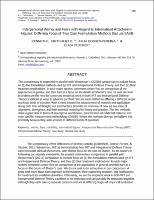Please use this identifier to cite or link to this item:
https://hdl.handle.net/20.500.12202/9343| Title: | The case of Sharon considered from the vantage point of interpersonal reconstructive therapy |
| Authors: | Critchfield, Kenneth L. Dobner-Pereira, Julia Stucker, Eliza |
| Keywords: | attachment case formulation copy process theory Structural Analysis of Social Behavior (SASB) Interpersonal Reconstructive Therapy (IRT) case study clinical case study |
| Issue Date: | 19-Apr-2021 |
| Publisher: | Rutgers University |
| Citation: | Critchfield, K. L., Dobner-Pereira, J., & Stucker, E. (2021). The case of Sharon considered from the vantage point of interpersonal reconstructive therapy.. Pragmatic Case Studies in Psychotherapy, 17(1), 42–62. https://doi.org/10.14713/pcsp.v17i1.2087 |
| Series/Report no.: | Pragmatic Case Studies in Psychotherapy;17(1) |
| Abstract: | In Interpersonal Reconstructive Therapy (IRT: Benjamin, 2003/2006; 2018) a case formulation is used to tailor interventions to each patient’s unique patterns. Using the IRT lens, psychopathology is understood as reflecting attempts to adapt to current environments using maladaptive rules and values that were learned and internalized in the context of close attachment relationships. IRT identifies precise ways in which early learning shapes present experience. Additionally, the "gift of love" (GOL) hypothesis posits that motivation to repeat maladaptive ways is linked to the wish to receive love and acceptance from specific internalized attachment figures by repeating their ways and values for the patient. The IRT case formulation has been shown to be reliable and valid (Critchfield, Benjamin, & Levenick, 2015). The therapy adherence measure is also reliable (Critchfield, Davis, Gunn, & Benjamin, 2008) and correlates well with retention as well as reduced symptoms and rehospitalization rates (Karpiak, Critchfield, & Benjamin, 2011) among "difficult to treat" patients characterized as having high levels of personality disorder, chronic and severe problems, and prior failed treatment attempts. To illustrate the case formulation process, an IRT formulation is applied to the case of a 28-year-old female patient for whom a poor outcome was documented. |
| Description: | Scholarly article / Open access |
| URI: | https://pcsp.nationalregister.org/index.php/pcsp/article/view/2087 https://hdl.handle.net/20.500.12202/9343 |
| ISSN: | 1553-0124 (online) |
| Appears in Collections: | Ferkauf Graduate School of Psychology: Faculty Publications |
Files in This Item:
| File | Description | Size | Format | |
|---|---|---|---|---|
| ruladmin,+6-pdf,+Critchfield+et+al.,+Comparing+.pdf | 211.83 kB | Adobe PDF |  View/Open |
This item is licensed under a Creative Commons License

